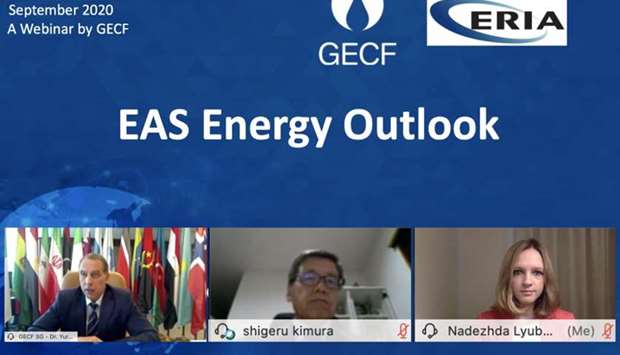The current energy saving goals and renewable energy policy in EAS (East Asia Summit) countries will contribute to reducing fossil fuel consumption as well as CO2 emissions mitigation, a senior official from the Economic Research Institute for ASEAN and East Asia (ERIA) said.
At the recent GECF Monthly Lecture Series on "EAS Energy Outlook", special adviser (Energy Affairs) to ERIA President, Shigeru Kimura said unless the US and China take the lead on this transformation, any shift towards the low carbon society will be inadequate.
“Further, seeing the ASEAN transition from 2017 to 2050 … the region is actually increasing coal, increasing natural gas, and increasing oil, but the renewables only get a little bit rise. That is the ASEAN reality,” Kimura noted during the online lecture.
EAS is a regional grouping of 18 countries, which brings together the Asean nations and countries in the Pacific Ocean, including Australia, China, Japan, South Korea, New Zealand, Russia, and the US.
The Jakarta-based ERIA has worked extensively with the EAS, particularly with its Energy Cooperation Task Force (ECTF) in driving its three major streams of promotion of energy efficiency and conservation (EEC), penetration of biofuels, and renewable and alternative power generation with research and data.
ERIA also compiles the biennial energy outlook of the EAS.
Appreciating the detailed presentation on the mechanics of the EAS Energy Outlook, GECF secretary general Yury Sentyurin said, “The suggestions you have made regarding the low carbon society are important for the GECF because we recognise the vital and crucial role that natural gas will play in energy transition and sustainable development, as well as in post-pandemic recovery.
“ERIA’s own projections (2015-2050) show that energy consumption in this important region of the world will increase by 2.5 times, while power generation demand will increase by three times during the same period. Here, I see potential for fuel substitution, especially in the power generation and transport sectors, if gas-based infrastructure affordability grows and more favourable policy measures are undertaken,” noted Sentyurin, while highlighting that these recommended steps are in line with the 2019 Malabo Declaration of the 5th GECF Gas Summit of Heads of State and Government, which also emphasises the importance of cooperation amongst various stakeholders.
The latest edition of the EAS Energy Outlook (2019-2020) estimates that the East Asia Summit countries will witness 3.1% increase in economic growth annually between 2017 and 2050, while its population will increase from 3.89bn in 2017 to 4.43bn in 2050.
At the same time until 2050, the share of fossil fuels in the EAS will be more than 80% in the business-as-usual scenario and 70% in the case of alternative-policy-scenario.
The EAS Energy Outlook also forecasts that between 2017 and 2050 the share of natural gas in the final energy consumption of the EAS region will increase from 12% to 14%.
According to Kimura, policymakers make informed decisions when they are fed the factual data. Forecasting of energy saving potential of EAS countries, thus, assumes vital importance to establish whether their EEC and renewable energy (RE) targets can be achieved.
| Special adviser (Energy Affairs) to ERIA President, Shigeru Kimura was speaking at the recent GECF Monthly Lecture Series on ‘EAS Energy Outlook’ |
“Further, seeing the ASEAN transition from 2017 to 2050 … the region is actually increasing coal, increasing natural gas, and increasing oil, but the renewables only get a little bit rise. That is the ASEAN reality,” Kimura noted during the online lecture.
EAS is a regional grouping of 18 countries, which brings together the Asean nations and countries in the Pacific Ocean, including Australia, China, Japan, South Korea, New Zealand, Russia, and the US.
The Jakarta-based ERIA has worked extensively with the EAS, particularly with its Energy Cooperation Task Force (ECTF) in driving its three major streams of promotion of energy efficiency and conservation (EEC), penetration of biofuels, and renewable and alternative power generation with research and data.
ERIA also compiles the biennial energy outlook of the EAS.
Appreciating the detailed presentation on the mechanics of the EAS Energy Outlook, GECF secretary general Yury Sentyurin said, “The suggestions you have made regarding the low carbon society are important for the GECF because we recognise the vital and crucial role that natural gas will play in energy transition and sustainable development, as well as in post-pandemic recovery.
“ERIA’s own projections (2015-2050) show that energy consumption in this important region of the world will increase by 2.5 times, while power generation demand will increase by three times during the same period. Here, I see potential for fuel substitution, especially in the power generation and transport sectors, if gas-based infrastructure affordability grows and more favourable policy measures are undertaken,” noted Sentyurin, while highlighting that these recommended steps are in line with the 2019 Malabo Declaration of the 5th GECF Gas Summit of Heads of State and Government, which also emphasises the importance of cooperation amongst various stakeholders.
The latest edition of the EAS Energy Outlook (2019-2020) estimates that the East Asia Summit countries will witness 3.1% increase in economic growth annually between 2017 and 2050, while its population will increase from 3.89bn in 2017 to 4.43bn in 2050.
At the same time until 2050, the share of fossil fuels in the EAS will be more than 80% in the business-as-usual scenario and 70% in the case of alternative-policy-scenario.
The EAS Energy Outlook also forecasts that between 2017 and 2050 the share of natural gas in the final energy consumption of the EAS region will increase from 12% to 14%.
According to Kimura, policymakers make informed decisions when they are fed the factual data. Forecasting of energy saving potential of EAS countries, thus, assumes vital importance to establish whether their EEC and renewable energy (RE) targets can be achieved.

